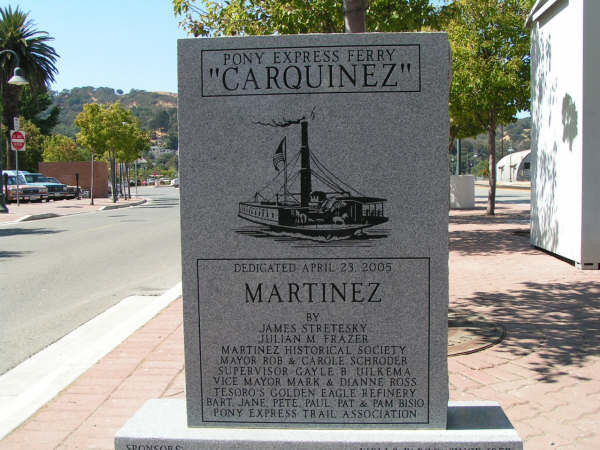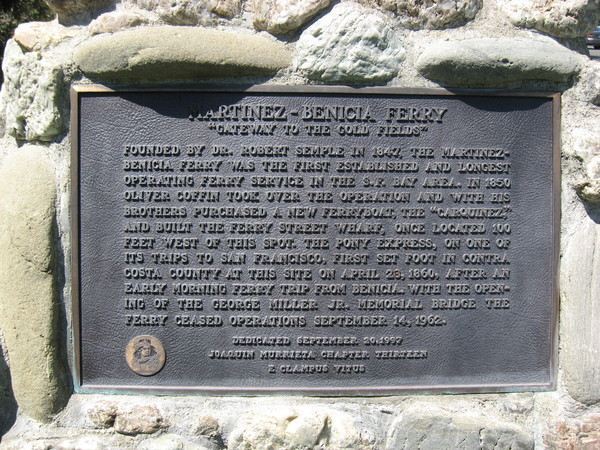By A. Paul Kraintz (AHS '72)
Most Californians are aware of the significant role the Bear Flag Revolt played in the formative years of this state's history. Probably few Martinez residents are aware that this same event had an indirect influence on the founding of their city by way of a ferry to its shores.
A young lieutenant in the revolt, Kentucky dentist Robert Semple, was charged with the escort of captured General Mariano C. Vallejo from Sonoma to New Helvetia (Sutter's Fort in Sacramento) in June of 1946. While crossing the vast properties of Vallejo's Suscol Grant, Semple first saw a stretch of land along the north shore of the Carquinez Straits which he envisioned as the ideal location for the greatest future seaport of the west coast.
Vallejo, impressed with the young man's enthusiasm and anxious to see his land developed, deeded a half interest on the property to Semple for the purpose of building his dream city. The grant carried two provisions: first that the city be named for Vallejo's wife, and second, that a ferry be established and operated across the straits to ensure access from the south to the new city.
Semple named his city "Francisca" (later renamed using her middle name, Benicia, to avoid confusion with San Francisco) and as owner-publisher of the only California newspaper, "The California", began to advertise in May of 1847 for the sale of lots and to announce the existence of his "Ferry at Francisca".
The first vessels were small oar and sail powered open scows which operated on an occasional bas, weather and traffic permitting, making a typical crossing in just less than a day. The intended landing at the south shore was on the beach anywhere between the Arroyo del Hambre (Alhambra Creek) and Cemetery Point. Strong winds and Currents would often carry the early ferry miles off course.
In pre-gold rush California the ferry proved an immediate success providing the most direct route between the territory's southern settlements at San Jose, Santa Clara, and Santa Cruz and the northern settlements of New Helvetia and Sonoma.
In 1847, when the ferry first appeared on the shore of the straits near the mouth of the Arroyo del Hambre, the valley was little more than grazing land for the ranchos owned by the Martinez family on the west and the Welsh family to the east. The existence of the ferry would soon change all that.
On January 24, 1848, James W. Marshall discovered gold on the south fork of the American River. As word of the find slowly spread throughout the west, traffic through the Alhambra Valley to the ferry increased dramatically. The memoirs of Charles L. Ross, an early California pioneer, tell of being the sole passenger making the crossing north one day in April, 1848, before the word of the gold had spread. Upon his return south in May he found two hundred wagons with teams, men, women and children, lined up on the south shore waiting to make the crossing north.

Dr. Semple's ferry had been converted to horse and mule power by this time through the use of ropes and capstans anchored on each shore. The vessel was only capable of transporting two wagons, including teams and passengers, per crossing and had begun day and night operations to meet the new demand. However, with most able boatmen gone in search of gold, he frequently had to operate the ferry himself.
Before long others attempted ferry operations on the straits. Most notably was a Captain Davis who put a schooner in service on the route. When winds and currents were favorable, the crossing was faster than on Semple's ferry. However, when the elements failed on at least one occasion, the crossing took days.
Meanwhile, Semple experimented with steam power by launching the vessel "Colusa" in June of 1848. The engine had been built from machinery available locally. The inability of the builders to properly synchronize the dual paddle wheels rendered the vessel unmaneuverable and it was withdrawn after its maiden voyage.
The steady stream of gold-seeking transients had transformed the Alhambra Valley from quiet rancho grazing lands to a main thoroughfare in the quest for gold. Inevitably, this mass of humanity awaiting passage at the southern terminus of the ferry would attract commercial enterprise to service their needs. The first trading post appeared in 1849, followed by the first residences, the beginnings of the town of Martinez.

